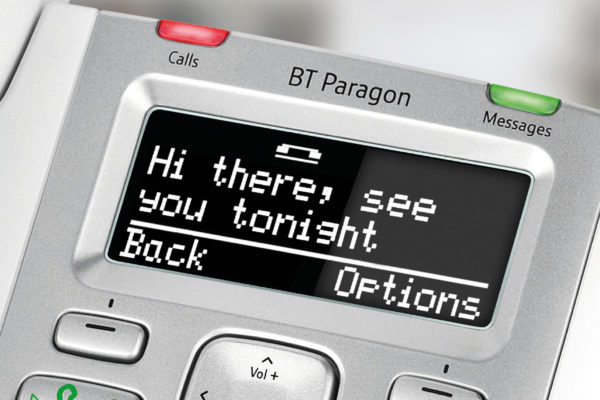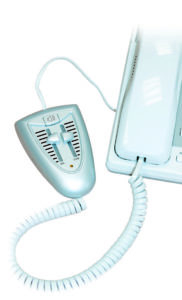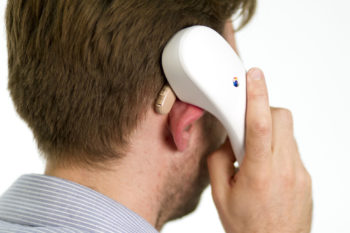Telephones

If you have a hearing loss and use the phone, you will need to think about some extra things, from the kind of phone you have to the way you use it.
Phone features
Lots of home phones and mobiles have features that can help people who have hearing loss or use a hearing aid. These include:
- Inductive coupler. This works like a hearing loop by making a wireless magnetic connection to your hearing aid when it’s on the ‘T’ setting to cut out interference and give you a clearer sound
- Amplification. Boosts the volume coming from the phone (so you may be able to use it without the aid). Amplification on cordless phones may not be very strong.
- Hands free. A hands free (loudspeaker) function means you don’t need to hold the phone as close to your hearing aid (or you may prefer to take out your aids). It’s useful if you wear two hearing aids because the sound will go to both ears – as if you’re chatting to another person in the same room.
- SMS text messaging. You can send and receive SMS text messages from phones with this feature. You’ll also need caller display for this to work (see below for more details).
- Caller display. See who’s calling on the phone’s display (you’ll need a caller ID service from your provider – charges may apply). This helps you to be prepared for the voice of the speaker, or decide whether to answer.
- Two-way record facility. Record your calls so you can go back and listen to them.
- Answering machine with slow playback. Play back messages and recorded calls slowly so you catch everything. This is available on the BT4500 Big Button – find out more at bt.com/includingyou
- Headset socket. Plug in a headset or neck loop. (Using a neck loop might help reduce any interference you might get from a cordless phone).
- Visual call indicator. Flashing light to let you know when the phone’s ringing.
- Internet. So you can use social media, email, apps and voice or video calls to communicate. Learn more about getting online.
More about assistive devices to help you get the best from your phone (streamers, bluetooth neck loop, headphones).

REMEMBER: cordless phones won’t work during power cuts because they need a power supply – so it’s worth having a simple corded or mobile phone for emergencies.
TIP: to help people hear what you’re saying on the phone, hold the mouthpiece below your bottom lip, in front of your chin. Modern mouthpieces are very sensitive and holding them too near to your mouth can distort what you’re saying.
Mobile phones
All mobile phones are digital which used to cause problems with interference. But newer technology means that you should be able to use a mobile phone with your digital hearing aids. If you use analogue hearing aids, you might get interference when you hold the phone up to the microphone or use the ‘T’ setting.
Looking for the right mobile phone? The Global Accessibility Reporting Initiative (GARI) is a project designed to help you find mobiles (as well as tablets and apps) with features that might help. It’s based in the USA but it includes some phones that are available in the UK. Find out more at gari.info
Lots of mobile phones have a loudspeaker, sometimes called ‘hands free’. This could be enough for you to be able to hold the mobile phone far enough away from your hearing aids to avoid interference. You might also be able to buy an inductive neck loop for your mobile phone. This either goes around your neck or hooks discreetly over your ear (next to a behind the ear hearing aid). They plug into the phone and come with a microphone that you can keep away from your hearing aids to avoid interference.
Bluetooth® inductive loops can be a bit pricey, but they should work with any Bluetooth-enabled mobile – so you don’t need to get a new loop or adapter if you change your mobile phone.
Made for iPhone hearing aids
Some hearing aids have a Made for iPhone (MFi) option. This uses a wireless connection to give you a clear sound when you use them with an Apple device like an iPhone or iPad (you can’t use this option with other phones). Contact Apple Support to find out more.
Positioning your home phone or mobile when you’re using hearing aids
When you’re on the phone, you need to make sure that the sound reaches your ear canal by moving it as close to the hearing aid microphone as possible. The best way to do this will depend on the kind of hearing aids you have. It’s a good idea to ask your audiologist.
Try holding the handset in different positions to find out what suits you best. One way of doing this is to listen to the dialling tone or a recorded announcement on a free phone number.
TIP: some people prefer to take out their hearing aid and use a phone with an amplifier.
Inductive couplers and the ‘T’ setting
A telecoil is a small part of a hearing aid that picks up magnetic signals from a hearing loop and converts the signals back into sound. This process doesn’t amplify the background noise, so you’ll get a clearer sound with less interference. A hearing loop in a phone is often called an inductive coupler. Hearing aids with a hearing loop will work like this when they’re on the ‘T’ setting (‘T’ stands for ‘telecoil’) or loop programme.
How do inductive couplers help?
An inductive coupler can reduce background noise and eliminate the feedback (squealing or whistling) that you sometimes get when you hold a phone next to your hearing aid.
How to tell if your phone has an inductive coupler
On your phone’s box it should say ‘hearing aid compatible’, ‘inductive coupler’ or ‘hearing loop’ and show an ‘ear’ symbol.
All BT corded phones with amplification also have inductive couplers. The amplifier can also be used to boost the speech volume when using your hearing aid on the ‘T’ setting. Some digital cordless phones also have inductive couplers.
Using an inductive coupler with hearing aids
The sound from a phone earpiece comes from the holes in the centre, but the inductive coupler (an electromagnet) is usually fitted around the rim of the earpiece. It’s often about a centimetre back from the holes. It’s important to hold the rim of the earpiece as close as possible to the magnetic pick-up in your hearing aid – maybe even touching your hearing aid.
You’ll need to experiment to find the best position for the handset and adjust the volume on the hearing aid or phone (or both) to a comfortable level. The magnetic coils in the phone and hearing aid work best if they’re aligned in the same direction. Most hearing aid manufacturers try to make the angle of the telecoil suit both phone and room loop use – but you could try rotating the phone
to see if the sound gets better.
Some hearing aids have a combined microphone and telecoil option (an ‘MT’ position) that picks up the sound coming both from the microphone and the inductive coupler. Some people like to
use this option, because it boosts the overall sound. But if you’re in a busy place, it’s probably best to choose telecoil only, to keep background noise down.
You can find more about using a phone with a hearing aid on the Making calling easier pages at bt.com/includingyou
Programmable telecoil option (PTO)
Some hearing aids have a programmable telecoil option (PTO). This can automatically choose the programmed setting (telecoil, microphone or microphone and telecoil) that you prefer for using the phone. With some hearing aids, it’s triggered automatically by your phone’s magnetic field.
Whistling
If your hearing aids whistle, it’s usually caused by feedback, when the microphone picks up the sounds going into your ear and amplifies them again. If you find you’re getting a whistling sound, here are some things to check:
- Is the mould or tip/dome fitted in your ear properly? If it needs to be changed, a visit to your audiologist will probably fix things.
- Is your hearing aid volume too high (this also distorts the speech)? Try using a phone with an amplifier so you can turn down the hearing aid’s volume and turn up the phone’s incoming speech volume. Try not to have it too loud though, or you’ll hear the whistling you’re trying to avoid.
- Twist the handset so that one edge of the earpiece is turned away from your ear. This will direct the sound away from the aid’s microphone, helping to stop the feedback cycle.
- Move the earpiece around until you find the place just before the whistling starts – this will help you get the loudest sound.
Using the phone with bone-anchored hearing aids or cochlear implants
In terms of positioning, bone-anchored hearing aids, cochlear implants, and non-implanted bone conduction hearing aids, are a bit different to conventional hearing aids. But the general principles of good phone technique are the same.
Depending on your hearing aid, the tips on page 30 still apply, and they’ll help you find out if you’re likely to get interference when you’re using a cordless or a mobile phone.
The hands free feature on some phones can be really useful, but remember to turn down the volume to the lowest comfortable level, to minimise distortion. This is especially important if you’re using a digital cordless phone – where the hands free amplification is built into the handset itself.
With newer cochlear implants, you can use your phone with either the microphone or the telecoil, or both. As with other hearing aids, you’ll need to experiment to find the best place and position to hold your phone.
Sending SMS text messages from a landline with BT Text
Text messaging (SMS) can be a great way to stay in touch. You can easily text from a mobile phone and, with BT Text and a compatible phone, you can do the same from your landline.
To send and receive texts on your BT line, you’ll need an SMS compatible phone and BT Caller Display (which you may be charged for). Text messages sent to standard phones or to lines without Caller Display will be delivered as voice messages. For charges and more information, go to bt.com/callingfeatures
Images courtesy of British Telecommunications plc.
